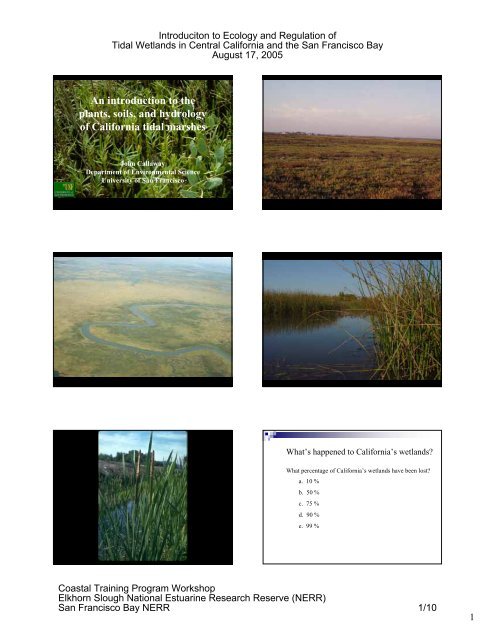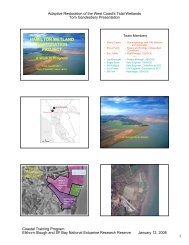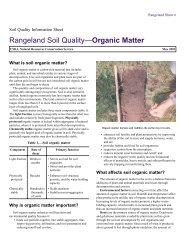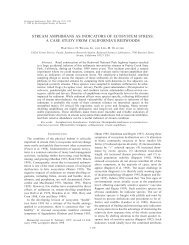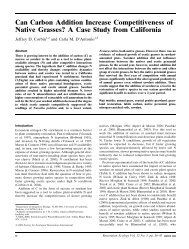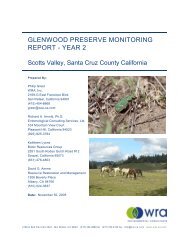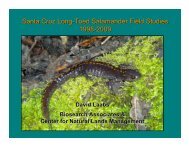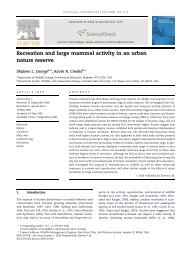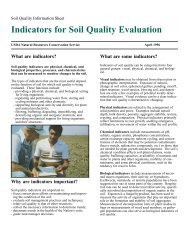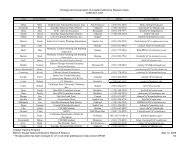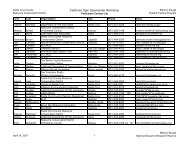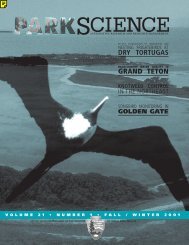Presentation: An introduciton to the plants, soils, and hydrology of ...
Presentation: An introduciton to the plants, soils, and hydrology of ...
Presentation: An introduciton to the plants, soils, and hydrology of ...
You also want an ePaper? Increase the reach of your titles
YUMPU automatically turns print PDFs into web optimized ePapers that Google loves.
Introduci<strong>to</strong>n <strong>to</strong> Ecology <strong>and</strong> Regulation <strong>of</strong><br />
Tidal Wetl<strong>and</strong>s in Central California <strong>and</strong> <strong>the</strong> San Francisco Bay<br />
August 17, 2005<br />
<strong>An</strong> introduction <strong>to</strong> <strong>the</strong><br />
<strong>plants</strong>, <strong>soils</strong>, <strong>and</strong> <strong>hydrology</strong><br />
<strong>of</strong> California tidal marshes<br />
John Callaway<br />
Department <strong>of</strong> Environmental Science<br />
University <strong>of</strong> San Francisco<br />
What’s happened <strong>to</strong> California’s wetl<strong>and</strong>s?<br />
What percentage <strong>of</strong> California’s wetl<strong>and</strong>s have been lost?<br />
a. 10 %<br />
b. 50 %<br />
c. 75 %<br />
d. 90 %<br />
e. 99 %<br />
Coastal Training Program Workshop<br />
Elkhorn Slough National Estuarine Research Reserve (NERR)<br />
San Francisco Bay NERR 1/10<br />
1
Introduci<strong>to</strong>n <strong>to</strong> Ecology <strong>and</strong> Regulation <strong>of</strong><br />
Tidal Wetl<strong>and</strong>s in Central California <strong>and</strong> <strong>the</strong> San Francisco Bay<br />
August 17, 2005<br />
Wetl<strong>and</strong> Loss in <strong>the</strong> United States<br />
400,000,000<br />
early 1800's<br />
25,000,000<br />
Wetl<strong>and</strong> Loss by State<br />
early 1800's<br />
Wetl<strong>and</strong> area (acres)<br />
300,000,000<br />
200,000,000<br />
100,000,000<br />
1980<br />
size <strong>of</strong> Calif.<br />
Wetl<strong>and</strong> area (acres)<br />
20,000,000<br />
15,000,000<br />
10,000,000<br />
5,000,000<br />
1980<br />
0<br />
United States Alaska Lower 48<br />
0<br />
FL LA TX MN MI NC<br />
(Dahl 1990)<br />
State<br />
(Dahl 1990)<br />
25,000,000<br />
Wetl<strong>and</strong> Loss by State<br />
early 1800's<br />
SF Bay Wetl<strong>and</strong>s Past <strong>and</strong> Present<br />
Wetl<strong>and</strong> area (acres)<br />
20,000,000<br />
15,000,000<br />
10,000,000<br />
5,000,000<br />
1980<br />
ca. 1850 ca. 1998<br />
0<br />
CA OR WA FL LA TX MN MI NC<br />
State<br />
(Dahl 1990)<br />
(from SFEI)<br />
A Quick Introduction <strong>to</strong> Tidal Marshes<br />
Underst<strong>and</strong>ing Tidal Marsh Hydrology<br />
• Hydrology<br />
tides<br />
freshwater inputs<br />
• Soils<br />
lack <strong>of</strong> oxygen<br />
salinity<br />
• Vegetation<br />
spatial patterns <strong>of</strong> distribution on a variety <strong>of</strong> scales<br />
adaptations<br />
common species<br />
• Hydroperiod<br />
frequency <strong>of</strong> inundation<br />
duration <strong>of</strong> inundation<br />
depth <strong>of</strong> inundation<br />
• Critical hydrological fac<strong>to</strong>rs<br />
tides<br />
freshwater inputs<br />
Coastal Training Program Workshop<br />
Elkhorn Slough National Estuarine Research Reserve (NERR)<br />
San Francisco Bay NERR 2/10<br />
2
Introduci<strong>to</strong>n <strong>to</strong> Ecology <strong>and</strong> Regulation <strong>of</strong><br />
Tidal Wetl<strong>and</strong>s in Central California <strong>and</strong> <strong>the</strong> San Francisco Bay<br />
August 17, 2005<br />
Tides<br />
• Mixed, semi-diurnal tides on Pacific Coast<br />
two highs <strong>and</strong> lows each day<br />
different heights<br />
• Elevation relative <strong>to</strong> <strong>the</strong> tides determines<br />
inundation regime<br />
• O<strong>the</strong>r coasts have different tidal patterns<br />
Tidal Variation across <strong>the</strong> Marsh<br />
regularly inundated<br />
rarely inundated<br />
low marsh<br />
mid-marsh plain<br />
high marsh -<br />
upl<strong>and</strong> transition<br />
Importance <strong>of</strong> Tidal Creeks<br />
Freshwater Inputs<br />
• deliver water, sediment<br />
<strong>and</strong> nutrients <strong>to</strong> marsh<br />
• flush salts from <strong>soils</strong><br />
• more important in salt<br />
marshes than in brackish<br />
<strong>and</strong> freshwater marshes<br />
• Large-scale variation up <strong>the</strong> estuary<br />
• Similar patterns up larger drainages<br />
• Finer-scale pattern within a marsh, <strong>and</strong><br />
associated with any local freshwater inputs<br />
• VERY DIFFERENT than o<strong>the</strong>r US tidal<br />
marshes (mediterranean climate)<br />
Coastal Training Program Workshop<br />
Elkhorn Slough National Estuarine Research Reserve (NERR)<br />
San Francisco Bay NERR 3/10<br />
3
Introduci<strong>to</strong>n <strong>to</strong> Ecology <strong>and</strong> Regulation <strong>of</strong><br />
Tidal Wetl<strong>and</strong>s in Central California <strong>and</strong> <strong>the</strong> San Francisco Bay<br />
August 17, 2005<br />
Spatial Variation in FW Inputs<br />
Salinity Variation across Salt <strong>and</strong> Brackish Marshes<br />
• greatest input from Delta<br />
• significant local inputs at<br />
many local rivers/creeks,<br />
including:<br />
• Napa R.<br />
• Petaluma R.<br />
•Alameda Creek<br />
• Coyote Creek<br />
more regular salinity<br />
low marsh<br />
mid-marsh plain<br />
more variable salinity<br />
(higher in summer <strong>and</strong><br />
lower in winter)<br />
high marsh -<br />
upl<strong>and</strong> transition<br />
Tidal Marsh Soils: Key Characteristics<br />
Tidal Marsh Soil Biogeochemistry<br />
• Fine texture (lots <strong>of</strong> clay <strong>and</strong> silt)<br />
• Poorly drained<br />
low oxygen levels (<strong>of</strong>ten no oxygen in soil)<br />
low redox status<br />
• High organic content<br />
• Moderate pH<br />
• Unusual biogeochemistry (anaerobic conditions)<br />
• Driven by anaerobic processes<br />
• Mix <strong>of</strong> aerobic <strong>and</strong> anaerobic zones in <strong>the</strong> soil<br />
• Sequence <strong>of</strong> oxidation-reduction reactions<br />
O 2 , NO 3- , Mn 4+ , Fe 3+ , SO<br />
2- 4 , CO 2 (oxidized forms)<br />
H 2 0, N 2 , Mn 2+ , Fe 2+ , S 2- , CH 4 (reduced forms)<br />
• Unusual nutrient dynamics<br />
especially nitrogen<br />
Tidal Marsh Soils<br />
Spatial Variation in Soil Fac<strong>to</strong>rs<br />
• Varying patterns across <strong>the</strong> marsh:<br />
saturation/inundation<br />
salinity<br />
• Seasonal patterns as well, especially salinity<br />
lower soil oxygen<br />
less variable salt<br />
higher soil oxygen<br />
more variable salt<br />
low marsh<br />
mid-marsh plain<br />
high marsh -<br />
upl<strong>and</strong> transition<br />
Coastal Training Program Workshop<br />
Elkhorn Slough National Estuarine Research Reserve (NERR)<br />
San Francisco Bay NERR 4/10<br />
4
Introduci<strong>to</strong>n <strong>to</strong> Ecology <strong>and</strong> Regulation <strong>of</strong><br />
Tidal Wetl<strong>and</strong>s in Central California <strong>and</strong> <strong>the</strong> San Francisco Bay<br />
August 17, 2005<br />
Plants: Key Fac<strong>to</strong>rs Affecting Distribution<br />
• Inundation (anaerobiosis, oxidation/reduction)<br />
• Salinity (both summer stress <strong>and</strong> winter/spring<br />
lows for germination)<br />
• Nutrients<br />
• Competition<br />
• His<strong>to</strong>ry<br />
Spatial <strong>and</strong> Temporal Variability<br />
• Spatial scales <strong>of</strong> variability<br />
estuarine-wide scale<br />
drainage scale<br />
within wetl<strong>and</strong> scale<br />
• Temporal scales <strong>of</strong> variability<br />
climate change<br />
inter-annual variation<br />
seasonal changes (recruitment)<br />
Tidal Marsh Plant Distributions<br />
Simplified Salt Marsh Plant Zonation<br />
• Salt Marsh<br />
• Brackish Marsh<br />
• Freshwater Marsh<br />
• Remember transitional-upl<strong>and</strong> species!!<br />
low marsh<br />
Spartina foliosa<br />
mid-marsh plain<br />
Salicornia virginica<br />
Zonation is similar in brackish marshes,<br />
but less obvious, <strong>and</strong> even less obvious<br />
in freshwater marshes.<br />
high marsh -<br />
upl<strong>and</strong> transition<br />
Salicornia virginica<br />
Frankenia salina<br />
Distichlis spicata<br />
Grindelia stricta<br />
Leymus triticoides<br />
Plant Zonation<br />
Plant Adaptations<br />
• <strong>An</strong>aerobiosis<br />
physical adaptations<br />
• aerenchyma <strong>and</strong> adventitious roots<br />
physiological adaptations<br />
• Salinity<br />
secrete salt<br />
o<strong>the</strong>r physiological adaptations<br />
(PWA <strong>and</strong> Faber 2005)<br />
Coastal Training Program Workshop<br />
Elkhorn Slough National Estuarine Research Reserve (NERR)<br />
San Francisco Bay NERR 5/10<br />
5
Introduci<strong>to</strong>n <strong>to</strong> Ecology <strong>and</strong> Regulation <strong>of</strong><br />
Tidal Wetl<strong>and</strong>s in Central California <strong>and</strong> <strong>the</strong> San Francisco Bay<br />
August 17, 2005<br />
Salt Marsh Plants<br />
• Spartina foliosa (cordgrass)<br />
• Salicornia virginica (pickleweed)<br />
• Jaumea carnosa (jaumea)<br />
• Distichlis spicata (saltgrass)<br />
• Frankenia salina (alkali heath)<br />
• Cuscuta salina (salt marsh dodder)<br />
• Atriplex triangularis (spearscale, fat-hen)<br />
• Triglochin maritima (seaside arrow-grass)<br />
• Limonium californicum (salt marsh rosemary, sea lavender)<br />
• Grindelia stricta (gumplant)<br />
• Leymus triticoides (creeping wildrye)<br />
Coastal Training Program Workshop<br />
Elkhorn Slough National Estuarine Research Reserve (NERR)<br />
San Francisco Bay NERR 6/10<br />
6
Introduci<strong>to</strong>n <strong>to</strong> Ecology <strong>and</strong> Regulation <strong>of</strong><br />
Tidal Wetl<strong>and</strong>s in Central California <strong>and</strong> <strong>the</strong> San Francisco Bay<br />
August 17, 2005<br />
Spartina foliosa<br />
Distichlis spicata<br />
Frankenia salina<br />
Limonium californicum<br />
Grindelia stricta<br />
Coastal Training Program Workshop<br />
Elkhorn Slough National Estuarine Research Reserve (NERR)<br />
San Francisco Bay NERR 7/10<br />
7
Introduci<strong>to</strong>n <strong>to</strong> Ecology <strong>and</strong> Regulation <strong>of</strong><br />
Tidal Wetl<strong>and</strong>s in Central California <strong>and</strong> <strong>the</strong> San Francisco Bay<br />
August 17, 2005<br />
Brackish Marsh Plants<br />
Scirpus maritimus<br />
• Scirpus maritimus (NOW: Bolboschoenus maritimus)<br />
• Scirpus californicus (NOW: Schoenoplectus californicus) (Calif. tule)<br />
• Scirpus acutus (NOW: Schoenoplectus acutus) (hardstem bulrush, tule)<br />
• Scirpus americanus (NOW: Schoenoplectus americanus)<br />
• Typha angustifolia (narrowleaf cattail)<br />
• Typha latifolia (broadleaf cattail)<br />
• Juncus spp. (rush)<br />
• Salicornia virginica<br />
• Distichlis spicata<br />
• Jaumea carnosa<br />
• Atriplex triangularis<br />
• Baccharis pilularis (coyote brush)<br />
• Rosa californica (California rose)<br />
Scirpus californicus<br />
Scirpus acutus<br />
Scirpus americanus<br />
Freshwater Marsh Plants<br />
• Typha angustifolia<br />
• Typha latifolia<br />
• Scirpus acutus<br />
• Scirpus californicus<br />
• Juncus spp.<br />
• Polygonum spp.<br />
• Sagittaria spp.<br />
• Rubus spp.<br />
• Salix spp.<br />
• Lilaeopsis masonii<br />
• Mimulus guttatus<br />
• Lycopus americanus<br />
• Calystegia sepium<br />
• AND MANY OTHER SPECIES!!<br />
Coastal Training Program Workshop<br />
Elkhorn Slough National Estuarine Research Reserve (NERR)<br />
San Francisco Bay NERR 8/10<br />
8
Introduci<strong>to</strong>n <strong>to</strong> Ecology <strong>and</strong> Regulation <strong>of</strong><br />
Tidal Wetl<strong>and</strong>s in Central California <strong>and</strong> <strong>the</strong> San Francisco Bay<br />
August 17, 2005<br />
Typha angustifolia<br />
Typha latifolia<br />
Rare Tidal Marsh Plants<br />
• Cordylanthus maritimus subsp. palustris<br />
• Cordylanthus mollis supsp. mollis<br />
• Cirsium hydrophilum<br />
• Aster lentus<br />
• Lathryus jepsonii var. jepsonii<br />
• Lilaeopsis masonii<br />
• AND MORE…<br />
Non-Native Tidal Marsh Plants<br />
• Spartina alterniflora (<strong>and</strong> hybrids with S. foliosa)<br />
• Lepidium latifolium (peppergrass)<br />
• Eichhornia crassipes (water hyacinth)<br />
• Cotula coronopifolia (brass but<strong>to</strong>ns)<br />
• Polypogon monspeliensis (rabbit’s-foot grass)<br />
• Rumex crispus (curly dock)<br />
• Phragmites australis (common reed)<br />
• AND MORE…<br />
Plant Summary<br />
• Mix <strong>of</strong> physical <strong>and</strong> biological fac<strong>to</strong>rs that affect<br />
plant distributions, including inundation <strong>and</strong> salinity<br />
• Diversity is reduced with higher salinity<br />
• Diversity is higher in <strong>the</strong> upper marsh<br />
• Creeks have strong role in salt marsh plant<br />
distribution, not so prominent in brackish <strong>and</strong><br />
freshwater tidal marshes<br />
• Upper marsh-transitional areas have many rare<br />
species, as well as many non-native invasives<br />
Coastal Training Program Workshop<br />
Elkhorn Slough National Estuarine Research Reserve (NERR)<br />
San Francisco Bay NERR 9/10<br />
9
Introduci<strong>to</strong>n <strong>to</strong> Ecology <strong>and</strong> Regulation <strong>of</strong><br />
Tidal Wetl<strong>and</strong>s in Central California <strong>and</strong> <strong>the</strong> San Francisco Bay<br />
August 17, 2005<br />
Acknowledgments<br />
• CalPho<strong>to</strong>s: Plants (for pho<strong>to</strong>s)<br />
http://elib.cs.berkeley.edu/pho<strong>to</strong>s/flora/<br />
• Philip Williams <strong>and</strong> Phyllis Faber (for reading<br />
on SF Bay wetl<strong>and</strong> res<strong>to</strong>ration)<br />
• Joy Zedler (additional readings)<br />
Coastal Training Program Workshop<br />
Elkhorn Slough National Estuarine Research Reserve (NERR)<br />
San Francisco Bay NERR 10/10<br />
10


